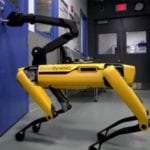 Politics
Politics  Politics
Politics  Weird Stuff
Weird Stuff 10 Freaky Times When Famous Body Parts Were Stolen
 Miscellaneous
Miscellaneous 10 Interesting Things Manufacturers Stopped Making and Why
 Gaming
Gaming 10 Funny Tutorials in Games
 History
History 10 Fascinating Little-Known Events in Mexican History
 Facts
Facts 10 Things You May Not Know about the Statue of Liberty
 Movies and TV
Movies and TV 10 Movie Adaptions That Brought Popular Songs to Life
 Health
Health 10 Miraculous Advances Toward Curing Incurable Diseases
 Miscellaneous
Miscellaneous 10 Undeniable Signs That People’s Views of Mushrooms Are Changing
 Animals
Animals 10 Strange Attempts to Smuggle Animals
 Politics
Politics 10 Countries Where Religion and Politics Are Inseparable
 Weird Stuff
Weird Stuff 10 Freaky Times When Famous Body Parts Were Stolen
 Miscellaneous
Miscellaneous 10 Interesting Things Manufacturers Stopped Making and Why
Who's Behind Listverse?

Jamie Frater
Head Editor
Jamie founded Listverse due to an insatiable desire to share fascinating, obscure, and bizarre facts. He has been a guest speaker on numerous national radio and television stations and is a five time published author.
More About Us Gaming
Gaming 10 Funny Tutorials in Games
 History
History 10 Fascinating Little-Known Events in Mexican History
 Facts
Facts 10 Things You May Not Know about the Statue of Liberty
 Movies and TV
Movies and TV 10 Movie Adaptions That Brought Popular Songs to Life
 Health
Health 10 Miraculous Advances Toward Curing Incurable Diseases
 Miscellaneous
Miscellaneous 10 Undeniable Signs That People’s Views of Mushrooms Are Changing
 Animals
Animals 10 Strange Attempts to Smuggle Animals
10 Attempts At Creating Perpetual Motion Technology
Perpetual motion technology has been fascinating people for a long time. Today, it’s widely accepted as little more than pseudoscience, but that certainly hasn’t stopped people from creating bigger, better, and more outlandish gadgets and gizmos in the hopes of breaking the laws of physics and revolutionizing the world.
10 Karpen’s Pile
In the 1950s, Romanian engineer Nicolae Vasilescu-Karpen invented a battery. Now housed (though not on display) at the National Technical Museum of Romania, the battery is still working, but no one has been able to figure out how and why it’s still running.
The actual battery in the machine is the same, simple, one-volt battery that Karpen installed in the 1950s. The machine itself has been in storage for some time, with the museum unable to afford the proper display and security for such an oddity. It was only discovered that it was still running when a Romanian newspaper went to see it on a presumably slow news day.
Having done his doctoral research and thesis on the effects of magnets on moving bodies in 1904, Karpen was a likely candidate to create something like this. By 1909, he was doing research into high-frequency currents and the transmission of telephone signals over longer distances. He built telegraph stations, researched ambient heat, and advanced fuel cell technology. But modern scientists still can’t figure out what’s going on with his strange battery.
There have been plenty of guesses, from thermal energy converted into mechanical energy in some sort of loop to a thermodynamic principle we haven’t discovered yet. The mathematics behind his invention appears to be mind-numbingly complex, potentially involving concepts like the thermal-siphon effect and scalar temperature field equations. Although we haven’t been able to create a perpetual motion machine capable of creating free energy, we’d still love this kind of life span for all our batteries.
9 Joe Newman’s Energy Machine
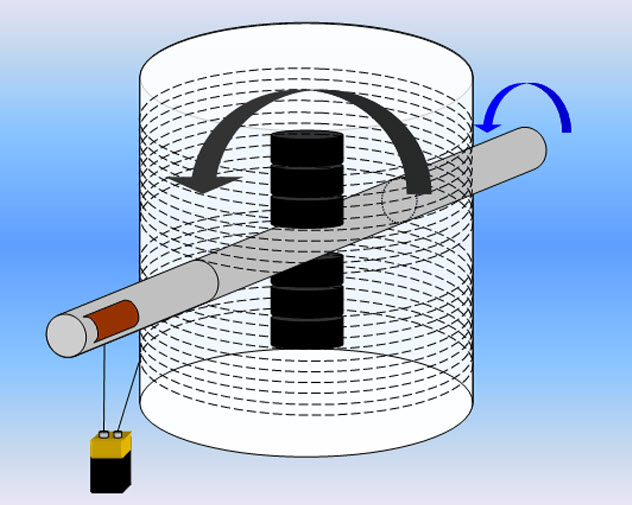
In 1911, the US Patent Office issued something of a blanket decree. They would no longer issue patents for perpetual motion or free energy devices because it appeared to be scientifically impossible to create such a thing. For some inventors, that meant that their battle to get their work recognized by legitimate science was going to be a bit more difficult.
In 1984, Joe Newman went on the CBS Evening News with Dan Rather and unveiled something that seemed to be world-changing. Still fresh off the oil crisis, everyone was excited by the idea that an inventor had created a perpetual motion machine that ran without using more energy and produced more energy than it absorbed.
Except the scientists, that is.
The National Bureau of Standards tested his device, which consisted mainly of a battery pack charged by a magnet rotating inside a wire coil. When tested, all of Newman’s claims fell through, although that didn’t stop some people from wanting to believe in him. Newman continued to take his Energy Machine on tour, demonstrating just how well it worked. More than 100 percent efficient, Newman claimed that his machines could put out 10 times the energy that went into them. When his patent applications were declined and the scientific community shoved his invention into the slush pile, he was heartbroken.
An amateur scientist who never finished high school, Newman didn’t give up even when no one was willing to back his plan. Convinced that God had made him the steward of a machine that was going to change mankind for the better, Newman always believed that the true worth of his machine was covered up by the powers that be.
8 Robert Fludd’s Water Screw
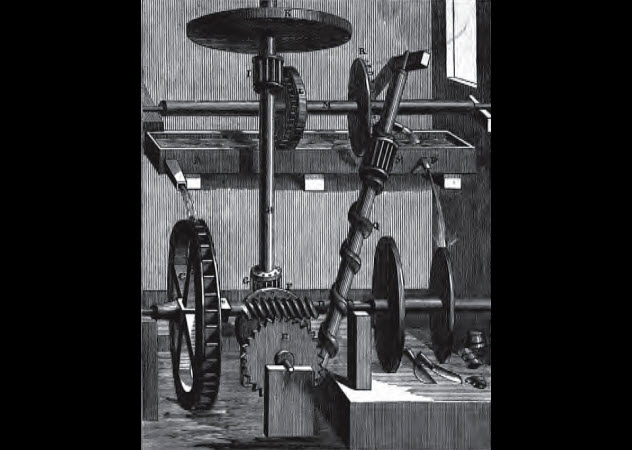
Robert Fludd was the sort of character that you only get at a particular time in history. Half scientist and half alchemist, Fludd was writing and inventing at the turn of the 17th century. He had some strange ideas, like believing that lightning was the earthly embodiment of God’s anger, which is why people got hit if they didn’t run. But Fludd also believed in some principles that we accept today, even if most people didn’t at that time.
His version of a perpetual motion machine was a water wheel that could grind grain while continually recirculating the water propelling the wheel. Fludd called it the “water screw.” When wood engravings of the idea were released in 1660 (the idea itself dates to about 1618), they were believed to be the first drawings or illustrations of their kind.
Needless to say, the device didn’t work. However, Fludd wasn’t just trying to break the laws of physics with his machine. He was also looking for a way to help farmers. At the time, grinding huge amounts of grain was dependent on streams. Those who lived far from a suitable source of running water were forced to load up their crops, haul them to the mill, and then take them back to the farm. If his perpetual motion machine had worked, it would have made life a lot easier for countless farmers.
7 Bhaskara’s Wheel
One of the earliest references to perpetual motion machines comes from the mathematician and astronomer Bhaskara in his writings from around 1150. His concept depended on an unbalanced wheel with a series of curved, mercury-filled spokes inside. As the wheel turned, the mercury would move, providing the push needed for the wheel to keep turning.
Over the centuries, there were more versions of the wheel created from that basic idea. It’s completely understandable why this seems like it should work: A constantly unbalanced wheel would naturally want to right itself, and theoretically, it should keep turning. Some designers had so much faith in their wheels that they designed brakes in case things got out of control.
With our modern understanding of force, friction, and work, we know that an unbalanced wheel won’t achieve the desired effect because we won’t get all the energy back, much less collect enough to need hand brakes. But the idea was intriguing, especially when viewed in its Hindu religious context of self-renewal and the circle of life. The concept remained so popular that wheel-shaped perpetual motion machines were seen in later Islamic and European writings.
6 Cox’s Timepiece
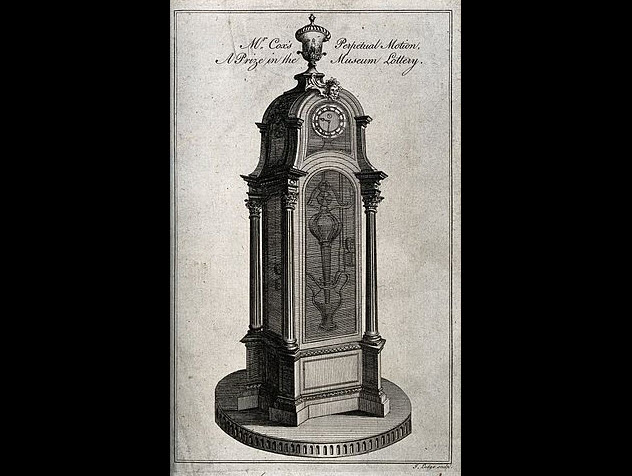
When famous London clockmaker James Cox built his perpetual motion timepiece in 1774, it was almost exactly as described in the accompanying literature that explained why the piece never needed winding. The six-page document revealed how the clock was created by a “union of the mechanic and philosophic principles.”
According to Cox, the diamond-powered clock’s constant motion and its reduction of internal friction to almost nothing guaranteed that the metals from which the clock was constructed would decay much more slowly than anyone had ever seen. Although that’s a grandiose statement, many presentations of new technology contained mystical elements back then.
While Cox’s timepiece wasn’t exactly a perpetual motion machine, it was an ingenious clock. Encased in glass that kept out dust while leaving its inner workings exposed to view, the clock was powered by changes in atmospheric pressure. Whether the mercury rose or fell inside the clock’s internal barometer, the movement of the mercury turned the inner wheels in the same direction, winding it a little bit at a time. If the clock was wound nearly all the way, the gears would shift out of place until the chain loosened to a certain point, where everything would slip back into place and the clock would start to wind itself again.
The first widely accepted example of a perpetual motion clock, it was first put on display by Cox himself at Spring Garden. Later, it was seen at the Weeks’ Mechanical Museum and then at the Clerkenwell Institute. The exhibition was such a marvel of the time that it was featured in countless fictional works, and Cox charged curious onlookers a mint to see his marvel.
5 Paul Baumann’s Testatika
Watchmaker Paul Baumann founded the spiritual community Methernitha in the 1950s. In addition to abstaining from alcohol, drugs, and tobacco, the members of this religious sect live in a self-sufficient, environmentally conscious way. To accomplish this, they claim to rely on a miraculous perpetual motion machine created by their founder.
Called the Testatika, the machine can supposedly harness unused electrical energy and turn it into power for the community. Sitting in an off-limits building, the Testatika has never been fully examined by scientists, although it was the subject of a brief documentary in 1999. Not much was shown, but the community swears by the nearly sacred machine.
The plans and properties of the Testatika were supposedly given to Baumann directly from God as he served a prison sentence for molesting a young girl. According to official lore, he was saddened by the darkness in his cell and the lack of light by which to read. Visited by a mysterious, mystical vision, he was given the secret to perpetual motion and infinite, environmentally conscious energy. Members of the sect confirm that the Testatika is God-given, saying that the few attempts to photograph the machine have shown it surrounded by a halo of multi-colored light.
In the 1990s, a Bulgarian physicist attempted to get the sect to reveal their designs for the machine, hoping to share this free energy device with the world. But he failed to convince them. When he committed suicide in 1997 by jumping out of a window, he left behind a note that read: “I did what I could, let those who can do better.”
4 Bessler’s Wheel
Johann Bessler began his research into perpetual motion with a simple concept like that of Bhaskara’s wheel: Weight a wheel on one side, and it’ll be perpetually unbalanced and constantly moving. On November 12, 1717, Bessler sealed his invention in a room. The door was locked and the room guarded. When it was opened two weeks later, the 3.7-meter (12 ft) diameter wheel was still turning. Sealing the room again, the pattern was repeated. When the door was unlocked in early January 1718, the wheel was still turning.
Even though it became a major hit, Bessler was rather secretive about how it worked, other than saying that the wheel relied on weights to keep it unbalanced. In fact, Bessler was so secretive that when an engineer sneaked a closer peek, Bessler went absolutely mental and destroyed the entire thing. The engineer later said that he hadn’t seen anything suspicious. However, he’d only looked at the outside of the wheel, so he had no idea how it actually worked. Even at that time, the idea of a perpetual motion machine was met with some cynicism. Centuries before, Leonardo da Vinci had mocked the idea of such a machine.
However, the concept of Bessler’s wheel has never gone entirely out of fashion. In 2014, Warwickshire engineer John Collins said that he had studied Bessler’s designs for years and was close to uncovering the mysteries of his wheel. Bessler once wrote that he had destroyed all evidence, blueprints, and drawings of how his wheel worked but added that anyone who was smart enough—and determined enough—would be able to figure it out.
3 Otis T. Carr’s UFO Engine
Listed in the Catalog of Copyright Entries (Third Series: 1958: July-December) is something a little odd. Even though the US Patent Office ruled long ago that they wouldn’t issue any patents for perpetual motion devices because such devices didn’t exist, OTC Enterprises, Inc., and its founder, Otis T. Carr, are listed as the owners of a “free energy system,” “peaceful atomic energy,” and a “gravity motor.”
In 1959, OTC Enterprises was supposed to kick off the maiden voyage of its “fourth dimensional space vehicle,” powered by a perpetual motion machine. Although at least one person briefly saw the jumbled pieces of the heavily guarded project, the craft was never unveiled and never took off. Instead, Carr was hospitalized with an unspecified ailment on the day the craft was due to take its maiden voyage.
Perhaps his illness was a clever way to get out of the demonstration, but it wasn’t enough to keep him out of prison. Having sold stock options in a technology that didn’t exist, Carr had taken advantage of investors interested in the project’s technology and people who believed the craft would return them to their extraterrestrial planet.
To get around patent restrictions on his crazy claims, Carr patented everything as an “amusement device” that would simulate trips into outer space. That was US Patent # 2,912,244 (with an issue date of November 10, 1959). Carr claimed that his supposedly spaceworthy craft was proven because one had already gotten away. The propulsion system was a “free energy circular foil” that allowed for the endless supply of energy needed to propel the craft into outer space.
Weirdness gave way to conspiracy theories on this one. Some people suggested that Carr actually got the perpetual motion engine working and the craft flying. But of course, it was promptly squashed by the US government. The theorists couldn’t agree on whether the government just didn’t want the technology out there or whether they wanted it for themselves.
2 Cornelis Drebbel’s Perpetuum Mobile
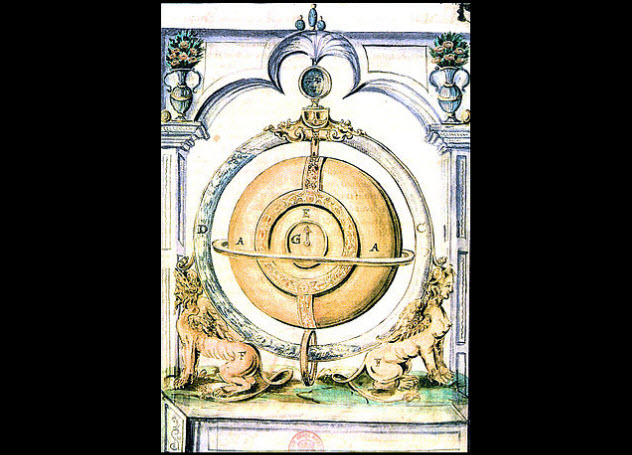
The strangest thing about Cornelis Drebbel’s perpetual motion machine is that even though we’re not sure what it was or how it worked, you’ve undoubtedly seen it more times than you realize.
Drebbel first demonstrated his machine in 1604 and amazed everyone, including England’s royal family. The machine was something of a timekeeper; it never needed winding and showed both the date and the phases of the Moon. Driven by changes in temperature or in the weather, his machine was powered by either an air thermoscope or a barometer, similar to Cox’s timepiece.
No one knows what provided the motion and energy for Drebbel’s device because he talked about harnessing the “fiery spirit of the air” like an alchemist. At the time, the world was still understood in terms of the four elements, but it was also a time when Drebbel was experimenting with sulfur and saltpeter.
As contained in a letter from 1604, the earliest-known representation of the device showed a central globe surrounded by a glass tube filled with liquid. Gold fittings and dials kept track of the phases of the Moon. Other depictions are more elaborate, showing the machine adorned with mythological creatures and gilded decorations. The Perpetuum Mobile also appeared in a number of paintings, particularly those having to do with Albrecht and Rubens. In those pictures, the machine’s odd, doughnut-shaped appearance didn’t seem like a globe at all.
Drebbel’s work attracted the attention of royal courts across Europe, and he toured the Continent for some time. Ultimately, though, he died poor. The uneducated son of a farmer, he gained the patronage of Buckingham Palace, invented one of the first submarines, and spent his twilight years keeping an alehouse after he became involved with some projects that went sideways and ruined his reputation.
1 David Hamel’s Antigravity Machine
In his self-proclaimed “incredible true life story,” David Hamel says that he is a simple carpenter with no formal education who was chosen to be the custodian of a free energy machine and a spacecraft for it to power. After meeting with extraterrestrials from the planet Kladen, Hamel claims that he received information that would change the world—if only people would believe him.
While it’s all a bit confusing, Hamel says that his perpetual motion engine uses the same energies that a spider uses to jump from one string of its web to the next. These scalar forces negate the pull of gravity and will ultimately allow him to build a craft that will reunite us with the Kladen natives that gave him this information in the first place.
If Hamel is to be believed, he’s already built such a device. Unfortunately, it flew away.
After working for 20 years to build this interstellar device and engine using a series of magnets, he finally turned it on, and that’s when it happened. Amid the glow of colorful ions, his antigravity machine rose into the air and shot off over the Pacific. To avoid a recurrence of this tragic event, Hamel is building his next machine out of heavy materials like granite.
To understand the principles behind the technology, Hamel says that you have to look at the pyramids, get some help from certain books that have been banned from mass circulation, accept the presence of unseen energy, and think of peanuts and peanut butter as representative of scalars and the ionosphere.







